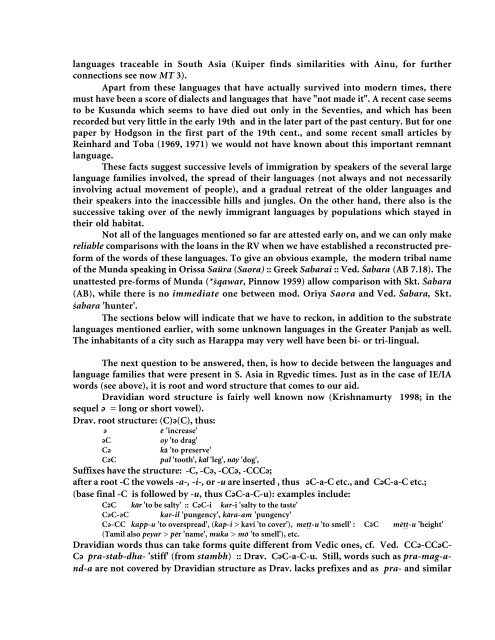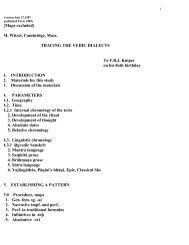The Languages of Harappa - People Fas Harvard
The Languages of Harappa - People Fas Harvard
The Languages of Harappa - People Fas Harvard
You also want an ePaper? Increase the reach of your titles
YUMPU automatically turns print PDFs into web optimized ePapers that Google loves.
languages traceable in South Asia (Kuiper finds similarities with Ainu, for further<br />
connections see now MT 3).<br />
Apart from these languages that have actually survived into modern times, there<br />
must have been a score <strong>of</strong> dialects and languages that have "not made it". A recent case seems<br />
to be Kusunda which seems to have died out only in the Seventies, and which has been<br />
recorded but very little in the early 19th and in the later part <strong>of</strong> the past century. But for one<br />
paper by Hodgson in the first part <strong>of</strong> the 19th cent., and some recent small articles by<br />
Reinhard and Toba (1969, 1971) we would not have known about this important remnant<br />
language.<br />
<strong>The</strong>se facts suggest successive levels <strong>of</strong> immigration by speakers <strong>of</strong> the several large<br />
language families involved, the spread <strong>of</strong> their languages (not always and not necessarily<br />
involving actual movement <strong>of</strong> people), and a gradual retreat <strong>of</strong> the older languages and<br />
their speakers into the inaccessible hills and jungles. On the other hand, there also is the<br />
successive taking over <strong>of</strong> the newly immigrant languages by populations which stayed in<br />
their old habitat.<br />
Not all <strong>of</strong> the languages mentioned so far are attested early on, and we can only make<br />
reliable comparisons with the loans in the RV when we have established a reconstructed preform<br />
<strong>of</strong> the words <strong>of</strong> these languages. To give an obvious example, the modern tribal name<br />
<strong>of</strong> the Munda speaking in Orissa Saüra (Saora) :: Greek Sabarai :: Ved. Śabara (AB 7.18). <strong>The</strong><br />
unattested pre-forms <strong>of</strong> Munda (*šqawar, Pinnow 1959) allow comparison with Skt. Śabara<br />
(AB), while there is no immediate one between mod. Oriya Saora and Ved. Śabara, Skt.<br />
śabara 'hunter'.<br />
<strong>The</strong> sections below will indicate that we have to reckon, in addition to the substrate<br />
languages mentioned earlier, with some unknown languages in the Greater Panjab as well.<br />
<strong>The</strong> inhabitants <strong>of</strong> a city such as <strong>Harappa</strong> may very well have been bi- or tri-lingual.<br />
<strong>The</strong> next question to be answered, then, is how to decide between the languages and<br />
language families that were present in S. Asia in gvedic times. Just as in the case <strong>of</strong> IE/IA<br />
words (see above), it is root and word structure that comes to our aid.<br />
Dravidian word structure is fairly well known now (Krishnamurty 1998; in the<br />
sequel ə = long or short vowel).<br />
Drav. root structure: (C)ə(C), thus:<br />
ə ẽ 'increase'<br />
əC oy 'to drag'<br />
Cə kå 'to preserve'<br />
CəC pal 'tooth', kål 'leg', nåy 'dog',<br />
Suffixes have the structure: -C, -Cə, -CCə, -CCCə;<br />
after a root -C the vowels -a-, -i-, or -u are inserted , thus əC-a-C etc., and CəC-a-C etc.;<br />
(base final -C is followed by -u, thus CəC-a-C-u): examples include:<br />
CC kår 'to be salty' :: CəC-i kar-i 'salty to the taste'<br />
CəC-əC kar-il 'pungency', kåra-am 'pungency'<br />
Cə-CC kapp-u 'to overspread', (kap-i > kavi 'to cover'), me-u 'to smell' : CC mẽ-u 'height'<br />
(Tamil also peyar > pẽr 'name', muka > mō 'to smell'), etc.<br />
Dravidian words thus can take forms quite different from Vedic ones, cf. Ved. CCə-CCəC-<br />
Cə pra-stab-dha- 'stiff' (from stambh) :: Drav. CəC-a-C-u. Still, words such as pra-mag-and-a<br />
are not covered by Dravidian structure as Drav. lacks prefixes and as pra- and similar

















